
| April Sky: Homer Hickam and the Caldwell March by Clara B. Cox M.A. '84 |
Photos by Col. Rock Roszak '71
|
When Katherine Caldwell Mendez, a 90-year-old niece of William Addison Caldwell, Virginia Tech's first student, told me in 1991 that her father and her Uncle Add had walked to campus from their home in Craig County, I never imagined that this newfound information would eventually cost me three toenails--and provide me with the opportunity to meet Homer Hickam (industrial engineering '64), author of October Sky and other popular novels.
To show his support for the Virginia Tech Corps of Cadets, Hickam joined about 350 members of the corps in April for their semi-annual Caldwell March. The fall and spring marches, each one a 13-mile trek, commemorate Add Caldwell's 26- to 28-mile walk to Blacksburg to become the first student to register when the school opened its doors in 1872. The spring march, a capstone event for freshmen, includes a grueling climb of about 900 feet in elevation to the top of Brush Mountain, followed by a toe-crunching descent on the other side before leveling out for an eight-mile hike to campus.
I tagged along for several reasons. Since conducting the research on Add Caldwell and writing an article about my findings [Virginia Tech Magazine, Vol. 14, No. 1, Fall 1991], I have felt a particular kinship with Add, and I wanted to participate in an event that commemorated what was, at least for the university, a significant milestone in his life.
Col. Rock Roszak (business management '71), associate director of alumni relations for the corps, somewhat reluctantly gave me permission to join the march. Although he never said as much, I'm sure he wondered if a 61-year-old woman who sits at a computer screen most of the time could even make it up the mountain, much less complete the entire trek.
|
|
CLIMB EVERY MOUNTAIN
A few weeks before the April 9 event, Roszak called me to say that Homer Hickam would be participating, providing yet another reason for me to make the hike: an opportunity not just to meet him, but also to interview him for Virginia Tech Magazine.
Although I walk two to three miles each day during the work week, I began conditioning by gradually adding more distance to my daily trek. Then, shortly before the march, Roszak phoned. "C2, let's have a brother-sister talk," he began, then proceeded to describe the rigorous nature of the climb up Brush Mountain, the perils of the trail itself, and the difficulties of getting anyone down if circumstances warranted. He suggested that I consider riding in the corps van to the top and then joining the march. I did--consider it, that is.
|
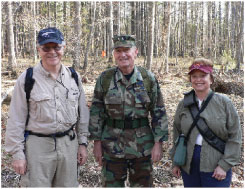 Homer Hickam '64, Maj. Gen. Jerry Allen, Homer Hickam '64, Maj. Gen. Jerry Allen,
and Clara Cox '84
|
|
April 9 dawned crystal clear and comfortably cool, and I headed to the Upper Quad to meet Hickam and his wife, Linda Terry Hickam, and to join them and Roszak for breakfast. Then we boarded a van for the ride to the trailhead in Craig Creek Valley, which lies between Sinking Creek and Brush mountains. Along the way, both Hickams joined Roszak in encouraging me to ride to the mountaintop, which was the route Linda planned to take before joining the march.
But when I saw the commandant, Maj. Gen. Jerry Allen, head into the meadow toward a creek we had to ford before starting up the mountain, I grabbed my gear and followed him, with Roszak and Hickam close behind. After wading the stream, we stripped off our wet sneakers, donned our hiking boots, tossed our wet stuff to Linda--who graciously carried them back to the van--and started up the trail.
I maintained the men's pace a third to half the way up before slowing down. When I realized that I couldn't keep pace, I encouraged them to continue rather than wait for me each time I stopped to catch my breath. "I won't get lost," I promised. "I know I can find the top." With that assurance, they moved on.
What had by then become for me a slow pace, interspersed with rest stops, allowed the first few companies in the corps to catch up with me.
"You're an inspiration, ma'am," more than one cadet said as a number of them passed me.
"How can anyone hanging onto a tree gasping for breath be an inspiration?" I wondered. But then I decided that they just hadn't expected to see anyone my age that far along the trail.
|
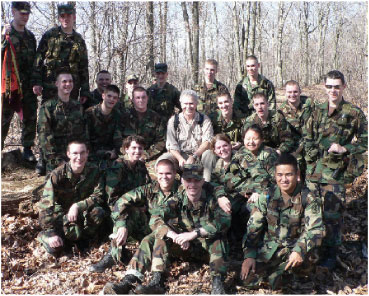 Hickam with members of the corps
Hickam with members of the corps
|
FORGING AHEAD
Finally, heels afire, blisters set, and heart pounding, I reached the top--still ahead of some of the cadets. Only then was I able to interview Hickam, who looked as if he had merely walked from his house to his car--while I huffed away.
"I've really been looking forward to this," he commented as we walked along the spine of the mountain. "This is a great tradition. I love it."
Hickam remembered that when he was in the corps, some of the military honor societies--Sash and Saber, and Scabbard and Blade, for example--did a lot of hiking and running long distances, but the corps itself did not. "That was something that we were missing," he said, emphasizing again, "This is great."
|
|
In addition to showing support for the corps, Hickam, who runs every day, said he wanted to participate in the event in order to "tune up for my summer dino-hunting trip," which involves walking all day long. The Montana badlands, where he searches for dinosaur bones, are hilly and covered with slippery rocks and deep cracks. "At least," I thought, "we don't have any cracks to contend with--and precious few hills."
I asked him about starting the tradition he and his friends in the corps began when they gathered materials and constructed Skipper, the cannon [Virginia Tech Magazine, Vol. 22, No. 4, Summer 2000] fired at football games. "When you're doing something like that, you don't realize that you're building something that's going to turn into a great story or a tradition," he responded. "We just wanted to build a cannon that was bigger and better than VMI had. Who knew that we would build something as long-lasting as the Skipper?"
Hickam fired the cannon twice during a football game last fall. "That was fun--more fun than the football game. I'd rather just go fire the cannon," he laughed. He said he liked the roar that went up from the crowd. "That's what it's all about, getting everyone all excited."
His comments made me think about Add Caldwell, who didn't realize that he was starting a tradition, either; he just wanted to make it to Blacksburg. We still don't know if he made his long walk with the intention of registering at the new land-grant college--he may have just wandered in out of curiosity.
I then asked Hickam what effect he thought the Caldwell March would have on the cadets walking with us. "I think it's great--it's a rite of passage. They'll have a definite sense of accomplishment," he responded. "You know, when you go through something that is arduous physically, that's a real bonding moment for everybody, including me. I'm bonding with these guys myself--that's great!”
"Now that you're part of the Caldwell March, what do you think of what Add Caldwell did?" I asked. "Well, if this was the route he picked," Hickam responded, "I think he should have ridden a mule." He said he admired the corps for making the difficult march. "It would be easier for everyone to just go run around the Drillfield and call it a day."
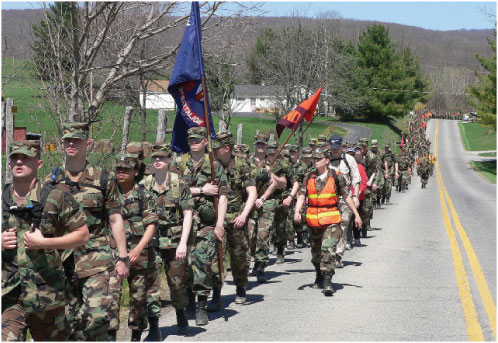
The actual route Caldwell took is unknown, but the route we took on April 9 probably was not part of it. The first half of the march, which is commemorated each fall by incoming freshmen and crosses Sinking Creek Mountain, more closely follows the first half of the route Caldwell is believed to have taken. Tracing what is believed to be the second half of Add's trek to Blacksburg would involve walking beside U.S. Route 460, so the commandant's office changed the route for safety reasons.
One cadet, a senior who had participated in both marches each of his four years at Tech (upperclassmen who train the freshmen also make the march), said the hike helps participants to remember Tech's past. "I like to get out in the field and do something like this rather than just sit around the Upper Quad or run around the Drillfield or whatever. It's a whole lot better than that. You're out in the woods walking around--and it's much more meaningful."
THE LONG WAY HOME
While I was interviewing Hickam, a number of cadets asked him to pose with them for photos. Said one, "It's pretty nice to see someone coming back and doing this, recognizing what we're doing since it's a tradition that only started a few years ago. Homer Hickam is definitely one of our more famous alumni, so it's nice to see him showing the support, walking with us."
When we reached the spot on the mountain where we would eat lunch before beginning our descent, I removed my boots and socks and applied moleskin to my blistered heels. I was afraid to sit down to eat the peanut butter and jelly sandwiches provided to the marchers because I thought I might not be able to get up again.
Before we hit the trail, a couple of members of the commandant's staff began urging me to ride the van down the mountain. "This part is a killer," Roszak told me. "It jams your toes into the front of your boots." I had had that experience once before--it cost me 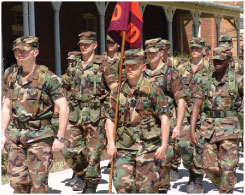 four toenails, my personal record--but I was determined to continue. The descent was so steep that I had to brace my legs to keep from running. And I learned quickly that Roszak was right; my toes ached relentlessly. four toenails, my personal record--but I was determined to continue. The descent was so steep that I had to brace my legs to keep from running. And I learned quickly that Roszak was right; my toes ached relentlessly.
Somehow, I reached the bottom of the mountain still standing. By then, the nice, cool day had become a hot one, adding to everyone's discomfort, although I didn't hear anyone complain. In fact, one cadet even started playing a harmonica.
During the next break, I switched my boots for my tennis shoes. They were still wet, but I was hoping that they would apply pressure someplace on my feet other than my toes. They didn't.
After the rest stop, I found myself walking beside the commandant at the head of the march and began asking him questions about why the corps broke the march into two parts. "For awhile we thought about doing the entire march--hiking halfway and camping out," Allen responded, "but we didn't have the equipment and it would have been a big undertaking to have 350 people camping out in the woods somewhere. So we decided to split it into a 13-mile hike in the fall and a 13-mile hike in the spring. It was about the same time that we came up with a phased training program for the freshmen, and it was convenient to have the fall Caldwell March as a milestone marking the end of the first phase of training for the freshmen.
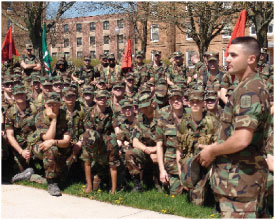 "The spring march," he continued, "signifies the end of the training program for the freshmen. I think the greatest thing about this march is that it is a team-building exercise. It's a physical challenge--going up Brush Mountain--and afterwards it's something the freshman class will talk about for years as 'something we did together.'" "The spring march," he continued, "signifies the end of the training program for the freshmen. I think the greatest thing about this march is that it is a team-building exercise. It's a physical challenge--going up Brush Mountain--and afterwards it's something the freshman class will talk about for years as 'something we did together.'"
As we walked through a Blacksburg neighborhood, Roszak pointed out that I was limping and encouraged me to ride the van from our last rest stop, which would be about a mile from campus. Most of the cadets had passed me by the time we reached that stop. I was tired and in pain, but I caught sight of Derring Hall and decided that I could suffer for at least one more mile.
I may not have come in dead last in the march if the cadets hadn't jogged most of that last mile--no one will ever know. But when I reached the Upper Quad, the march was over. Dead last or not, it was heartening to hear a contingent of the Highty-Tighties welcoming us with music, and I felt a sense of accomplishment. I had made it--against the odds, it seemed.
The hike gave me a greater appreciation for Add Caldwell--and knowing that Homer Hickam completed the march added to my admiration for him.
The experience was unique--but it won't be for too much longer. The commandant has already given me permission to join the fall march. I wonder if I'll have all my toenails by then.
|
|